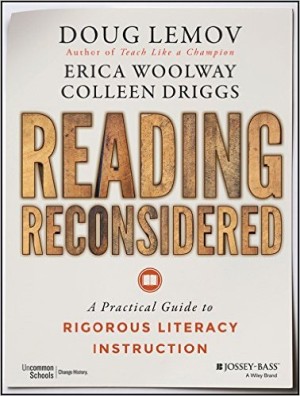04.18.16Building Autonomy via the ‘Literary Analysis Protocol’
 Chapter 8 of Reading Reconsidered describes tools teachers can use to build Intellectual Autonomy… students’ ability to ask and answer their own questions of a text. One of the tools we describe in the book is the literary analysis protocol, an exercise where a teacher regularly gives students a short passage from a book and asks them to analyze it, with the steps inherent in analysis being established in advance.
Chapter 8 of Reading Reconsidered describes tools teachers can use to build Intellectual Autonomy… students’ ability to ask and answer their own questions of a text. One of the tools we describe in the book is the literary analysis protocol, an exercise where a teacher regularly gives students a short passage from a book and asks them to analyze it, with the steps inherent in analysis being established in advance.
In Reading Reconsidered we propose that analyzing a passage consist of answering these four questions:
- Identify the characters in the passage—those who speak and those who play a significant role.
- Identify where in the plot of the book the scene takes place (that is, before or after what? And if relevant, foreshadowing, alluding to or referring back to what?
- Explain how the scene discusses or reflects on theme(s) or idea(s) that are important to the larger text.
- Compare the scene in the passage to at least one other scene in this novel/story or in something else the class has read, explaining how the themes, ideas, and motifs are portrayed.
Students might do this a few times a week on their own and then perhaps be given a few important passages as part of a unit test. In either case the question might look like this:
Analyze the following passage from The Giver:
Lily,” her mother said fondly, “you’re very close to being an Eight, and when you’re an Eight, your comfort object will be taken away. It will be recycled to the younger children. You should be starting to go off to sleep without it. “
But her father had already gone to the shelf and taken down the stuffed elephant which was kept there. Many of the comfort objects, like Lily’s, were soft, stuffed, imaginary creatures. Jonas’s had been called a bear.
“Here you are, Lily-billy, ” he said. “I’ll come help you remove your hair ribbons. “
Jonas and his mother rolled their eyes, yet they watched affectionately as Lily and her father headed to her sleeping-room with the stuffed elephant that had been given to her as her comfort object when she was born.
Here are the sample student answers from Reading Reconsidered. The numbered paragraphs refer to the four questions above, which students would understand are implicit in being asked to “analyze.”
- This scene involves Jonas, the novel’s protagonist, and his younger sister, Lily, who is going to bed. It also describes his father, who is always nurturing, handing the comfort object to his children, and Jonas’s mother, who is more analytical, observing the rest of the family.”
- This scene occurs early in the novel as Jonas watches his sister, Lily, going to bed. It’s a scene that shows more about Jonas’s home life and reveals how different and strange the world of the Community is compared to ours. The author describes Jonas’s comfort object as a “bear” as if that was some imaginary thing. It implies that bears no longer exist by the time this story takes place.
- “The use of the phrase ‘comfort object’ reminds me of the term ‘family unit.’ They are descriptions of things that sound almost normal, but really the things are not what they appear. They’re strange and sad. The ‘comfort objects’ are stuffed animals, but they don’t know what animals are called anymore. Earlier in the book when Jonas’s “family unit” was described, it turned out that people don’t choose who they marry. They’re matched. And then children are given to them and they aren’t their own. So it’s like a family, but it’s not really a family. Over and over the book describes normal life that’s so different and strange.”
- One of the key ideas in The Giver is that people are so controlled by the Community. Their families are made for them! But of course they don’t realize it. They think they’re normal. That’s what societies do. They put normal names on the crazy things they do, and that makes people think they’re normal. “This reminds me of the scene, later, where Jonas get his ‘job.’ That’s given to him as well. He doesn’t even get to choose, but he just tells the story like, ‘of course someone decided what my job is’ just like in this scene he thinks ‘of course someone assembled my family for me.’”
The idea here is to teach the steps implicit in open-ended interpretation, and to let students practice them in small manageable doses over and over and over.
So… Do you have similar tools you use in your classroom to build the skills of autonomy? If so what are they and how do they work?
